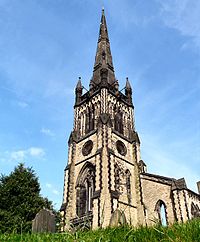- Christ Church, Heaton Norris
-
Christ Church, Heaton Norris 
Tower of Christ Church, Heaton NorrisLocation in Greater Manchester Coordinates: 53°24′52″N 2°10′04″W / 53.4144°N 2.1678°W OS grid reference SJ 889 908 Location Wellington Road,
Heaton Norris, Stockport, Greater ManchesterCountry England Denomination Anglican Website Churches Conservation Trust Architecture Functional status Redundant Heritage designation Grade II Designated 10 March 1975 Architect(s) William Hayley Architectural type Church Style Gothic Revival
(Early English style)Groundbreaking 1844 Completed 1846 Construction cost c. £7,000
(£502,000 as of 2011)Specifications Materials Sandstone,
Welsh slate roofsChrist Church, Heaton Norris, consists of the remains of a redundant Anglican church in Wellington Road, Heaton Norris, Stockport, Greater Manchester, England. Only the tower and part of the walls of the aisles survive. They are located on the crest of a hill on the main road linking Stockport with Manchester.[1] The church remains have been designated by English Heritage as a Grade II listed building,[2] and are under the care of the Churches Conservation Trust.[3]
Contents
History
The church was built in 1844–46 on land donated by Wilbraham Egerton of Tatton Park.[1] It cost about £7,000 (£502,000 as of 2011),[2][4] and was a Commissioners' church, the Church Building Commission providing a grant of £500 towards its building.[5] It was designed by the Manchester architect William Hayley. As originally built, it consisted of a nave, north and south aisles, north and south transepts, a chancel, and a west tower with a spire.
By the 1970s the fabric of the church was in very poor condition, including the effects of dry rot. Attempts were made to convert it into a centre for the use of the community, but these were unsuccessful, and in 1977 it was badly damaged by a fire. Following this, it was demolished apart from the tower and spire, and parts of the adjoining walls. The foundations of the other walls have been preserved to show its original plan. None of the fittings or furniture have survived; they were either destroyed in the fire or have been stolen. The five clock bells, made by Warner in 1896, were stolen in 1977.[3] The church was declared redundant on 20 July 1973, and the remains of the church were vested in the Trust on 23 May 1979.[6]
Architecture
Christ Church is constructed in yellow sandstone with a Welsh slate roof. Its architectural style is Early English.[2] The tower is in four stages, and it has a tall, slender spire.[3] On the west side of the lowest stage is a portal, and above this in the next stage is a west window with plate tracery. On the north and south sides of this stage are paired lancet windows. In the third stage are circular openings that formerly housed the clock faces and in the top stage are paired bell openings. On the summit is a pierced parapet, with tall pinnacles at the corners and smaller intermediate pinnacles.[1][2] In the Buildings of England series, it is stated to be Hayley's "most ambitious surviving work".[1]
See also
- List of churches preserved by the Churches Conservation Trust in Northern England
References
- ^ a b c d Hartwell, Clare; Hyde, Matthew; Pevsner, Nikolaus (2004), Lancashire: Manchester and the South-East, The Buildings of England, New Haven and London: Yale University Press, p. 233, ISBN 0-300-10583-5
- ^ a b c d "Christ Church, Stockport", The National Heritage List for England (English Heritage), 2011, http://list.english-heritage.org.uk/resultsingle.aspx?uid=1067165, retrieved 16 May 2011
- ^ a b c Christ Church, Heaton Norris, Lancashire, Churches Conservation Trust, http://www.visitchurches.org.uk/Ourchurches/Completelistofchurches/Christ-Church-Heaton-Norris-Lancashire/, retrieved 28 March 2011
- ^ UK CPI inflation numbers based on data available from Lawrence H. Officer (2010) "What Were the UK Earnings and Prices Then?" MeasuringWorth.
- ^ Port, M. H. (2006), 600 New Churches: The Church Building Commission 1818-1856 (2nd ed.), Reading: Spire Books, p. 335, ISBN 978-1-904965-08-4
- ^ (PDF) Diocese of Manchester: All Schemes, Church Commissioners/Statistics, Church of England, 2010, p. 6, http://www.churchofengland.org/media/810742/manchester%20-%20all%20schemes.pdf, retrieved 3 April 2011
Categories:- Church ruins
- Ruins in Greater Manchester
- Grade II* listed buildings in Greater Manchester
- Religious buildings completed in 1846
- 19th-century Church of England church buildings
- Anglican congregations established in the 19th century
- Gothic Revival architecture in England
- Commissioners' churches
- Churches preserved by the Churches Conservation Trust
Wikimedia Foundation. 2010.

